Buffalo Rises
by Anthony Chase
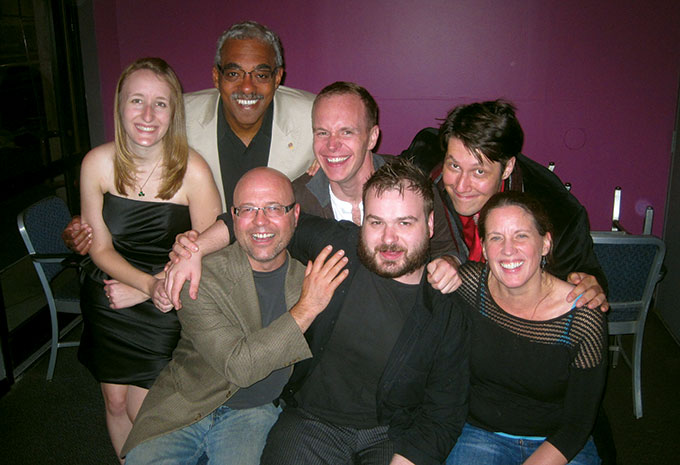
Eight 10-minute Plays at Road Less Traveled Productions
I’ve long contended that the main ingredient standing between Buffalo and national prominence as a center for theater is a community of local playwrights. Playwright David Mamet has often described how writers from Chicago are shaped by that city’s unique duality, “the admixture of the populist and the intellectual.”
And what has Dublin got that we haven’t got? Well, that would be William Butler Yeats, Samuel Beckett, J. M. Synge, Seán O’Casey, Brendan Behan, and let’s not even get into the litany of playwrights who would best be called Dublin-born, Shaw and Wilde among them.
Okay, so we’ve got some work to do. In playwriting, if the boats don’t rise together, they tend to launch out on their own—often never to return. How long can playwrights A. R. Gurney and Tom Dudzick be expected to fly our flag alone?
Happily, a whole fleet of locally built boats seems to be rising in Buffalo’s cultural harbor. Buffalo Rises, the current festival of short plays from Road Less Traveled Productions, features eight plays by eight Buffalo playwrights. It was joyful, even historic to see seven of the eight interacting with collegiality at the opening night. RLTP is dedicated to the development and production of new plays by local playwrights. Over the past 10 years, they’ve staged 22 world premieres and have truly established a community of writers. More than ever, we are seeing the fruit of these efforts.
This exceptional evening of new plays is, by turns, charming, engaging, and thought-provoking. It was a requirement for inclusion in the festival to script a positive depiction of our fair, if oft-misrepresented city.
The result exceeds all reasonable expectations.
As with the Irish theater of the early 20th century, or Chicago writers of the late century, these Buffalo playwrights are embracing the distinct sounds of English as spoken here, as well as the unique quirks of Buffalo culture and society. As in those other cities, these eight Buffalo writers also seem driven to correct disparaging impressions of this place, our climate, and our culture. If their ascent continues, we may come to know ourselves through them.
Some of the plays serve to recapture nearly forgotten episodes of Buffalo’s history (The Man Who Saved the President, Almost by Gary Earl Ross and Mad Dogs by Ibn Shabazz); to celebrate Buffalo’s changing neighborhoods (Good Neighbors by Caitlin McAneney and Steps by Darryl Schneider); and to defend a much loved city that has been maligned by an outside world (On the Eastern Shores of Lake Erie by Justin Karcher; Bride of Buffalo Movie by Jon Elston; The Fountain at Gates Circle by Matthew Crehan Higgins; and Spirit of Buffalo by Donna Hoke). Along the way they reveal Buffalo’s diversity, its class divisions, its idiosyncrasies, its obsessions, and its sense of pride in highly entertaining fashion.
All of the plays are abundantly competent and engaging. Naturally, in a festival of this playful “made to order” nature, some are more successful than others. Here is a rundown…
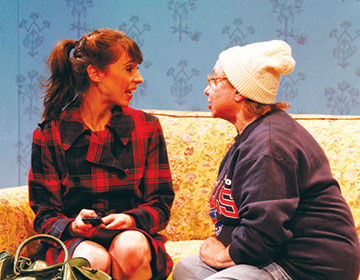
Good Neighbors
by Caitlin McAneney
In the second play, Caitlin McAneney explores a classic Buffalo situation, the working class Buffalonian who has escaped to prosperity, but who, for reasons of family obligation, returns to the old neighborhood. Bonnie Jean Taylor plays Eilley Maloney, the refined ex-Buffalonian who, thanks to family sacrifice, has been afforded a Canisius education. She has inherited her grandmother’s modest South Buffalo home in the old working-class Irish neighborhood where Betty O’Neil, played with delicious Buffalo verve and vinegar by Darleen Pickering-Hummert, confronts her. The play is an appeal for hometown values, and the resolution is as heart-warming as it is unlikely. Jonathan Shuey plays Eilley’s boyfriend from her teen years and David Mitchell plays the real estate agent charged to sell a house of questionable price but inestimable value.

Mad Dogs
by Ibn Shabazz
Ibn Shabazz gave RLTP one of its biggest hits with Insidious, which took the Artie Award for new play and went on to a successful run at St. Louis Black Repertory Company. Here, Shabazz takes us back to the East Side rioting of 1967, an event that was not so much forgotten as it was actively suppressed by government and the press. In this play, a young boy from Queens comes to visit family on Jefferson Avenue in the wake of the violence and is inspired to a life of leadership and service. His name is Byron Brown. One of the more lively exchanges has Judson, as a cop on the beat, explain to young Byron, played by Malik Springs, what a mayor is. As in Insidious, Shabazz deftly plays with issues of moral ambiguity and historic irony.

The Man Who Saved the President, Almost
by Gary Earl Ross
Winner of the 2005 Edgar Award for Best Play from the Mystery Writers of America for his play Matter of Intent, which debuted at Ujima Theater Company, Ross has adapted this play from his own novel, Blackbird Rising. Here he explores the story of James Benjamin Parker, an African-American man who was among those who tackled Leon Czolgosz after he had shot President McKinley at the Pan American Exhibition in Buffalo, 1901. At Czolgosz’s trial, no mention was made of Parker’s involvement, and despite the presence of eyewitnesses, he was subsequently called a liar. The play gives an impressive opening to the evening. In a town where “diversity” typically means “mostly white,” it was refreshing to give this play about an episode in Buffalo’s African-American history the opening spot of the evening and to populate the piece with such distinguished actors: Willie Judson, Candace Whitfield, and Greg Howze. In this short play, Ross showcases his unsurpassed power to intrigue—a talent that has drawn him to classic detective fiction, to Alfred Hitchcock, and, in this case, to mysteries of history. His play sets a high standard for the evening and energizes the audience with palpable anticipation for what is to follow.
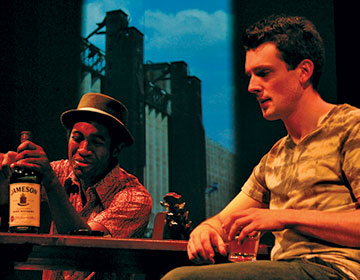
On the Eastern Shore of Lake Erie
by Justin Karcher
Among the strongest new writers on the Buffalo playwriting scene, Justin Karcher’s bold and sprawling riff on the Dracula story at American Repertory Theater of Western New York, The Dead English, got many to sit up and take notice with the vastness of its ambition. In this play, Karcher explores reasons people leave Buffalo and reasons to stay. The conversation between John and Percy, played by Howze and Shuey, yields flashes of insight and humor. Paradoxically, while the writing here is very good, the play meanders. Karcher evokes two vivid characters at a critical juncture in their lives, but does not drive the drama forward in any compelling direction. This is the sort of play that makes us yearn for the introduction of an additional element. Still, we should all be watching this gifted writer.
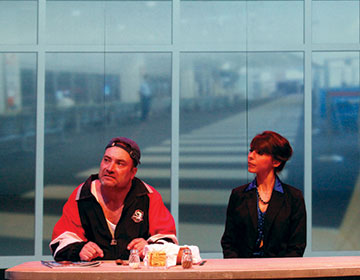
Bride of Buffalo Movie
by Jon Elston
Jon Elston, RLTPs literary director and the author of a number of highly satisfying plays, displays his flair for comedy in this pleasing piece about a devoted Buffalonian named Buster Tynpoon who thinks he has an idea that will put Buffalo back on the map. He makes his pitch in the restaurant of the Buffalo airport to Maria Shelley, a leader in the city’s not-for-profit cultural scene. Oil meets water in the fabulous interaction of Mitchell and Taylor in these roles. Surprisingly, as often as not, it is Mitchell who plays straight man to Taylor’s withering looks and tart quips. Indeed, she seems, at times, to be channeling Christine Baranski. This terrific pair, with Whitfield as the knowing and long-suffering waitress, make hay of Elston’s clever and tightly structured script.
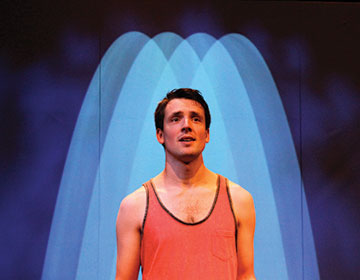
The Fountain at the Gates
by Matthew Crehan Higgins
Known as a gifted monologist, Higgins often performs his own work. In this piece, that duty is assigned to Shuey, certainly one of the city’s best actors, and one of its least appreciated, who plays a gay man who discusses feelings for the city that occur to him while jogging. The author of six plays, Higgins’s autobiographical Confessions took the top prize at the 2004 National Gay & Lesbian Theater Festival. While this piece excels as an ode to Buffalo, it would benefit from higher stakes. The challenge with monologue is to find ways to show rather than tell. In each instance, this piece explains rather too much while reaching rather obvious conclusions. This presents an obstacle for the unlucky actor who resorts to a superficial and mannered reading. The gifted author has assembled all of the ingredients, but this piece seems one draft shy of a finished monologue.
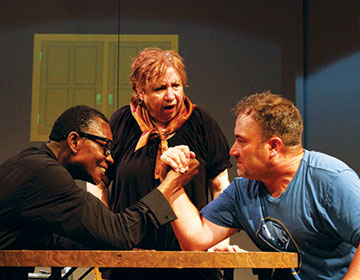
Steps
by Darryl Schneider
Closely akin to McAneney’s Good Neighbors, this play takes a rougher look at Buffalo’s changing neighborhoods. Here Hummert becomes Carmella, one of the last Italian-American homeowners in a neighborhood with changing demographics. Her Catholic faith has helped her build a bridge to recently appointed African-American priest Father Dumas (played by Judson), but her son Angelo (played by Mitchell) has developed feelings of embittered hate and frustration for the world. A crisis ensues when Carmella volunteers Angelo’s skill in masonry to repair the church steps. This is a beautifully crafted play that takes familiar character types and throws them into a scenario with unexpected turns. The cast handles the material expertly.
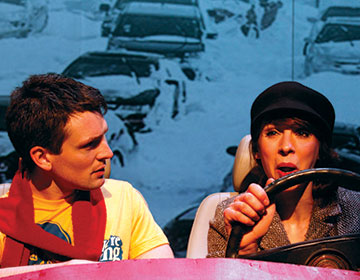
Spirit of Buffalo
by Donna Hoke
In terms of playful invention and polish, the best is saved for last. Donna Hoke confidently transports the audience into the realm of magical reality, confining us inside a car stuck on the New York State Thruway during a snowstorm. Taylor, plays the hapless driver and Buffalo expatriate Pomona. She is joined by Beau, played by Shuey, who, fearing that his own car is running low on gasoline, is ostensibly seeking warmth. Three good Samaritans visit the car, each bearing an iconic (or wishful) Buffalo form of sustenance. Hoke skillfully builds the laughs as she manipulates Buffalo stereotypes. Her capable cast is uniformly in top form here: Taylor as Pomona, Shuey as Beau, Hummert as the Samaritan with coffee, Whitfield as the Samaritan with beef on weck, and Judson as the Samaritan with loganberry martinis. It is especially fun to see Judson, better known for austere characters, here tapping into his talent for impish clowning. Nancy Parisi’s video design has the magical snowstorm rising and rising around the car until all the world disappears in its blanket of white.
•
RLTP co-founder and artistic/executive director Scott Behrend directs. Taking on the duties to interpret eight distinct and dissimilar plays is a high order, and while it is possible that the less developed work might have benefited from more focused attention, his vision for the evening is inspired, and the overall result is enormously engaging and satisfying.
Playwriting is the centerpiece of the enterprise, but it bears mention that Behrend arranged for the evening to have a vivid and exhilarating look. With historic images of Buffalo provided by Chuck LaChuisa and each play given a distinctive look by a different artist, the physical production has a fantastic kinetic energy and sense of dynamism, especially as we move from one play to the next. Reed Rankin designed the set and eye-popping projection design, which works brilliantly. In addition to Parisi, artwork for individual plays was supplied by John Jennings, Dana Saylor, Max Collins, Alana Fajemisin, A. J. Fries, Julian Montague, and Bruce Adams.
Buffalo Rises continues through October 6. See the On the Boards for details.
|
Issue Navigation> Issue Index > v12n38 (Week of Thursday, September 19) > Buffalo Rises This Week's Issue • Artvoice Daily • Artvoice TV • Events Calendar • Classifieds |









 Current Issue
Current Issue